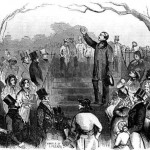The constitution Indiana’s forefathers drafted in 1816 established a precedent in its commitment to public education. The state’s charter mandated a system of free schooling extending from township schools all the way up to a state university.
State-funded elementary education, however, remained largely theoretical in Indiana for most of the nineteenth century.
The reality of pioneer life was not conducive to the development of free public schools. The economic privations most early settlers faced limited their income, and subsequently the tax base required to fund the schools. Additionally, many settlers took a dim view of compulsory education because it would rob them of much-needed hands on the homestead.
A state-authorized school system was spelled out in Indiana’s new constitution, adopted in 1851. A state superintendent of education was appointed the following year, along with of a state board of education.
Nonetheless, various factions continued to object to the idea of compulsory, tax-supported education on the grounds that it was anti-democratic. Additional distrust of secular schooling existed among religious communities, many of which had their own schools and colleges.
During the second half of the 19th century, Indiana lagged behind Ohio and Michigan in developing a public school system.
Significant strides were made once the legislature passed the first comprehensive compulsory education law in 1897, and authorized direct state funding of schools in 1905.
The quality of schools, however, was inconsistent in the largely rural state. Despite efforts toward centralizing the educational system, there were, in 1890, 10,000 separate townships, cities and other entities charged with financing the state’s schools, only 600 of which were larger than one-room schoolhouses.
By 1920, when larger municipalities such as Gary and Indianapolis were receiving acclaim for their educational advances, there were still 6,000 one-room schoolhouses in Indiana.
For further reading:
Robert Osgood, “Education in the Name of ‘Improvement’: The Influence of Eugenic Thought and Practice in Indiana’s Public Schools, 1900-1930. Indiana Magazine of History, Vol. 106, No. 3. (September 2010), 272-299.






















